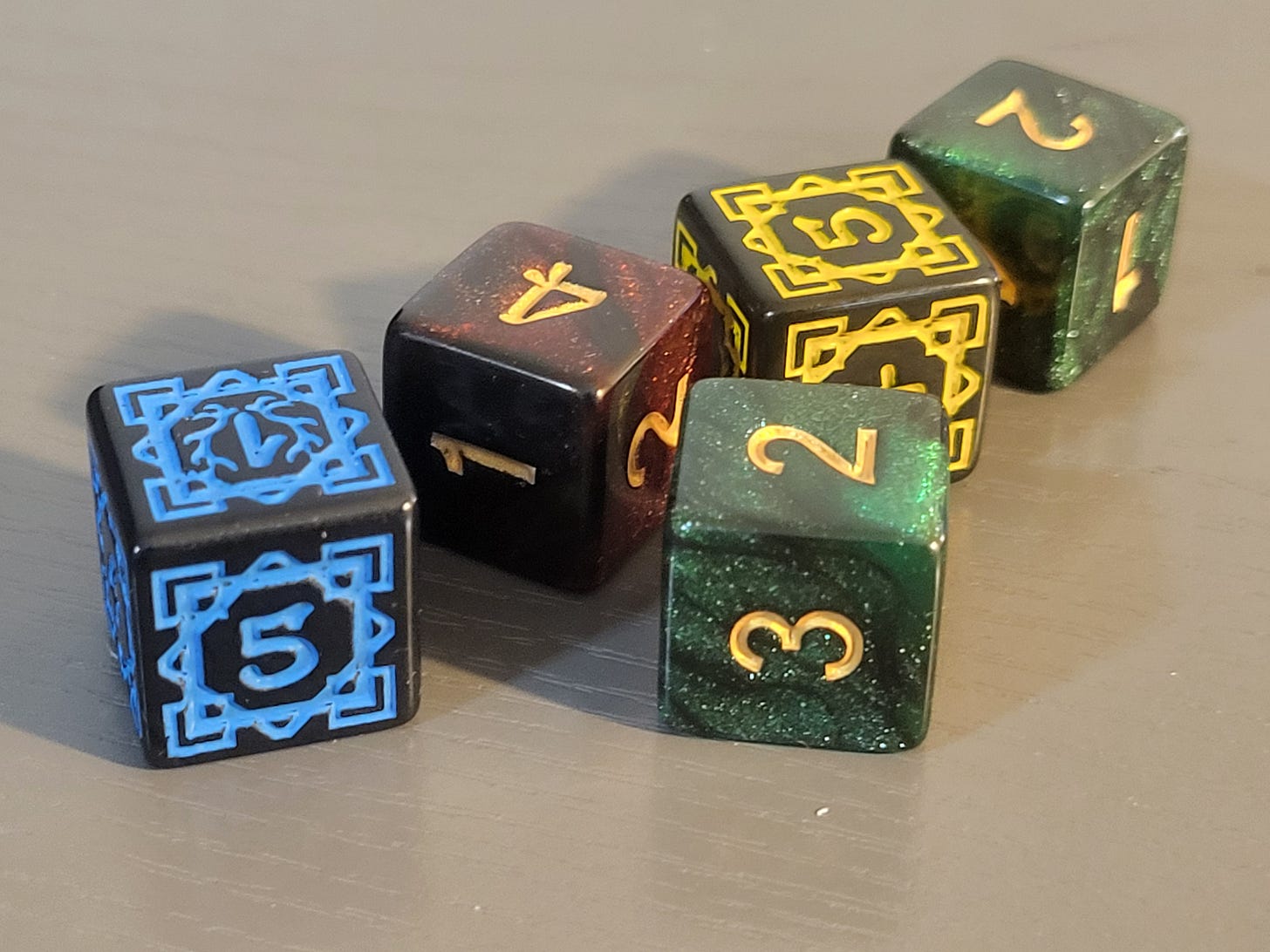I’ve been playing two solo games recently, Kal Arath by
and the playtest version of Niv Lova by . These have provided some great opportunities for ongoing actual play write-ups.There’s a lot of combat in these sandbox-style games. Each is infested with all sorts of vile beasts and fiendish enemies. Of course, both games have a random reaction table. One quick roll lets me know if they’re friends, foes, or somewhere in between.
But what happens when the fighting starts?
How close are they? Do they just shoot or hack in a wild frenzy? Or are they aggressive and cautious?Yes, you can ask several questions to the Yes/No oracle. Or you could decide what makes the best story.
Niv Lova does include an encounter range table. The encounter might be very close, giving you little opportunity to hide. You might also see them from afar, giving you ample time to position yourself for an ambush or avoid the encounter entirely.
However, I think solo players are invested in their characters, and there’s an inherent bias towards giving yourself the advantage.
To offset this, I’ve created a few new oracles and mechanics. The situations that benefit the player are all higher numbers. Use advantages, disadvantages, bonuses, or penalties as desired to reflect the player's actions, skills, or attributes.
Maybe they’ll be useful to your gaming as well.
Conditions of Encounter
Surprise (2d6)
2 – Player completely surprised and ambushed (1st round lose initiative, 2nd round initiative at disadvantage)
3 – Player surprised and ambushed (1st round lose initiative)
4 – Player caught off guard (1st round initiative at disadvantage)
5-9 – Neither party is surprised
10 – Opponents caught off guard (1st round initiative at advantage)
11 – Opponents surprised and can be ambushed (1st round win initiative)
12 – Opponents completely surprised and can be ambushed (1st round win initiative, 2nd round initiative at advantage)Battlefield Situation (2d6)
2 – Player caught out in the open, opponents have solid cover and/or elevated positions
3 – Player caught out in the open, opponents can quickly move to cover and/or high ground on the first round and still attack with ranged weapons
4 – Player caught out in the open, opponents can move to cover and/or high ground in their first round
5-9 – Neither part has the advantage of cover or better terrain
10 – Opponents caught out in the open, player can move to cover and/or high ground in their first round
11 – Opponents caught out in the open, player can move to cover and/or high ground in their first round and still attack with ranged weapons
12 – Opponents caught out in the open, player has solid cover and/or elevated positionsNow that we’ve established that, how do the opponents attack?
The following oracles give some insight into the tactics of the opponents. I reserve these for opponents who are trained in some way. I don’t use them for random groups or unintelligent monsters.
Ambush Set-Up (d6)
1 - Linear ambush
2 - L-Shaped Ambush
3 - V-Shaped Ambush
4 – Circular Ambush (only with melee weapons)
5 - Trap then V-Shaped Ambush
6 - Trap then L-Shaped AmbushI’ve recently been writing some pieces on my Substack about ambushes, so look at those for more info.
Circular ambushes with ranged weapons mean friendly fire casualties are likely. No bueno.
Opponent Actions
Opponent Battle Tactics (d6)
1 – Reckless - Full-on frontal assault without cover
2 – Leapfrog Assault – The opponents assault forward with half the party firing from cover while the other half move forward
3 – Spread Out – The opponents spread out and look for cover (if ranged) or close fast (if melee weapons)
4 – Flanking – Some of the opponents assault forward while a portion attempt to flank from the side
5 – Pincer – Opponents move forward in three groups – Left, Center, Right – Center group gives ground and the flanks try to trap the players between
6 - Focused Targets - Opponents will identify party leaders and those with the heaviest weapons and focus their attacks therePerfect, now what about failed morale? Well-trained people usually don’t just turn their backs and run. Sometimes panic sets in, but a well-disciplined disengagement is more likely if they think they’re losing.
Failed Morale (d6)
1-3 – Complete rout - opponents run or try to surrender
4 – Fighting withdrawal -opponents attack then move back attempting to disengage
5 – Fighting withdrawal – some opponents sacrifice themselves to help the others get away
6 – Fighting withdrawal – opponents some item (smoke, grenades, spells, etc) to shield their retreatAgain, these might add some spice to your OSR-style gaming. If there aren’t rules for cover, retreat, etc., assign advantages or disadvantages as you see fit.
If you routinely encounter a specific type of enemy (goblins, soldiers, mercs, etc.), giving them some ‘typical’ battle tactics may make sense. As players learn these, they can adjust based on the opponent’s expected moves. But be careful, intelligent well-led opponents may adjust and surprise you.
Hopefully, these are useful.
Let me know in the comments what you think or how your encounters go.




Great article with some very interesting tables and mechanics to add life to encounters.
I really like the varied combat tables. This can spice the action up nicely!